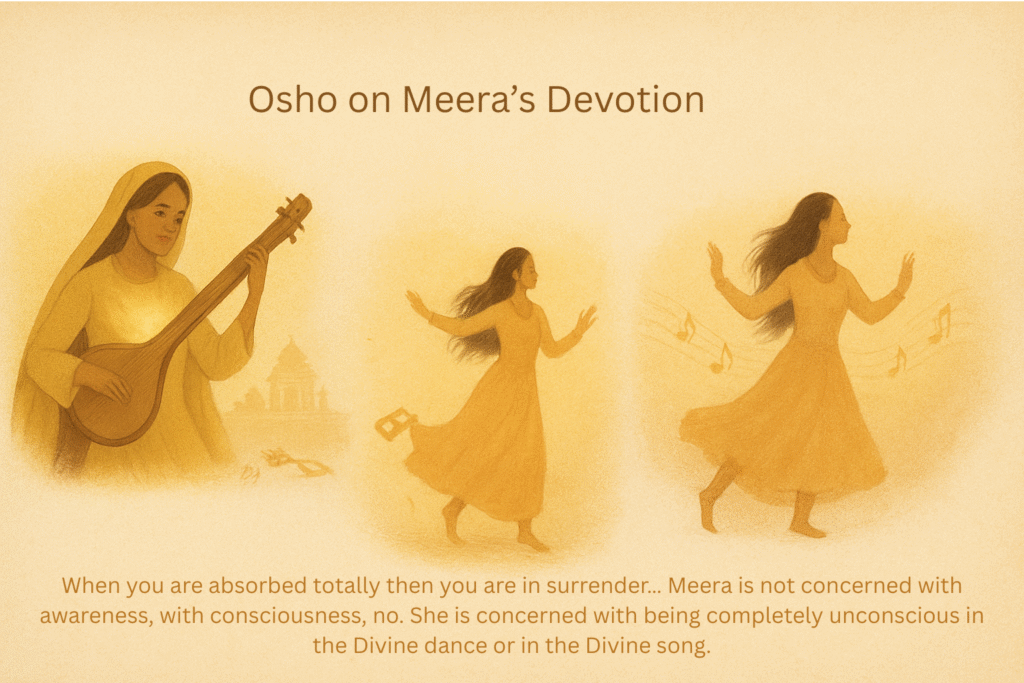Osho on Meera: The Flame of Divine Madness and Eternal Love
In the vast tapestry of spiritual seekers, few souls have burned as brightly and as wildly as Meera Bai. Osho, the enlightened master, saw in Meera not just a woman, but a living flame of devotion so intense that it transcended logic, society, and even sanity. Meera Bai was a rebel, a lover, and a saint who chose to drown in the ocean of Divine Love, Krishna’s love. Osho’s talks on Meera are a compelling invitation to experience love without boundaries, to awaken the heart beyond the cage of reason and convention.
The Rebel Who Loved Beyond Limits
Born into royal lineage in Rajasthan, India, Meera Bai’s life seemed predestined to be one of privilege, duty, and societal decorum. But from an early age, her heart belonged to Krishna alone. Unlike the deities kept in temples as distant idols, for Meera, Krishna was her beloved living presence. She spoke to him, sang to him, and danced in his honour as if he stood before her in flesh and blood.

Osho delighted in telling how Meera broke free from the chains of tradition and expectations. Married into a royal family, she refused to be a typical Rajasthani princess confined by royal duties. Rejecting the palace’s luxury for the innocent temple’s freedom, Meera’s songs of love echoed like a wild river that could not be dammed.
To the onlooking world, Meera appeared mad—mad with love and madness of the divine. She defied her husband, family, caste, and court alike. Osho says that in doing so, Meera showed us the essence of love—it asks no permission, it bows to no one, and it moves freely beyond societal norms. As Osho said, “Meera was proof that love needs no logic, no permission. Love is its own authority. She defied her husband, her family, her caste, her society, all for a love that breached all boundaries.”
Her rebellion was not angry defiance but a radical surrender to the supreme Beloved.
Devotion as Divine Madness
Osho often described Meera’s devotion as the purest form of spiritual madness, a madness that liberates. Where society sees madness, the divine sees devotion’s highest truth. Meera’s every song, every tear, every step was an expression of boundless love and surrender. She married Krishna with all her heart and soul and declared, “How can I belong to another?”
Osho beautifully captured this when he said, “Meera’s madness was not the madness of the mind, but the madness of the heart, the madness of surrender, the madness of divine love. Such madness is total awakening where one moves beyond ordinary existence.”
This divine madness of Meera is a pilgrimage beyond the mind and ego, a fiery flame that burns the self and gives birth to blissful freedom. Osho explained that such madness is not a lack of reason but a higher wisdom that transcends the mundane. Through this lens, Meera becomes not a tragic figure but a triumphant beacon of feminine spiritual strength. As he said, “Her devotion was not blind faith, it was a path of inner revolution, burning the ego and opening the door to liberation. Meera was the first freedom fighter of true love.”
The Eternal Lake of Love
Osho poetically described Meera’s love as a lake—a pristine, endless ocean made not of water but of her tears and devotion, purer than the holiest rivers. To enter this lake, he said, one must become like a swan—a seeker who yearns for the pearl of truth in the depths of love.
Her life teaches us that true spirituality is not about dry rituals or empty duties. It is about immersing ourselves fully in love—love that doesn’t calculate, love that defies logic, and love that surrenders all fears and conditions. It is an open invitation to dive into the lake of divine emotion and find ourselves lost and found at once.
Osho framed this transformational act of surrender as, “This is the door of love, once you step in, there is no coming back. Meera took that step, and immortality was hers.”
The Radical Freedom of Love
What makes her timeless is her fearlessness. No poison, no sword, no condemnation could extinguish the fire that blazed inside her devoted heart. She lived in total freedom, the freedom that arises when love becomes the only law, when surrender frees the soul from the prison of ‘should’ and ‘must.’
Osho invites us to see her not only in the historical context but as a living spark within us. Her courage to love beyond conditions, her joyous madness, her defiance of the world’s restrictions are symbols for anyone who seeks true inner freedom. He reminds us that, “Love is the supreme freedom. To love as Meera did is to become mad in the eyes of the world, but in that madness lies the ultimate enlightenment.”
Lessons from Meera by Osho
- Love needs no approval: Meera teaches that love is its own authority. It does not need society, tradition, or even logic to validate it.
- Surrender is strength: True surrender is not weakness but the most potent force that burns away ego and brings liberation.
- Madness can be divine: Sometimes, what looks like madness to the world is the soul’s deepest truth expressing itself.
- Inner freedom over external conformity: Meera chose love and devotion over royal life and social acceptance, showing the path to authentic freedom.
- Devotion as inner revolution: Devotion is not passive but a fire that transforms and awakens spiritual consciousness.
Bringing Meera’s Spirit into Today
In these modern times, where the mind often dominates and the heart feels blocked, Meera’s story is a powerful reminder to reconnect with love’s wildness. Osho’s teachings invite us to ignite that flame of passion within, to dance with divine madness, and to embrace the purity of surrender.
Osho’s reflections on her are more than just teachings on a historical saint; they are an invitation to live with an open heart, fearless, free, wild, and completely surrendered to the ecstasy of life itself.
If You want to join our upcoming camps, please contact us
